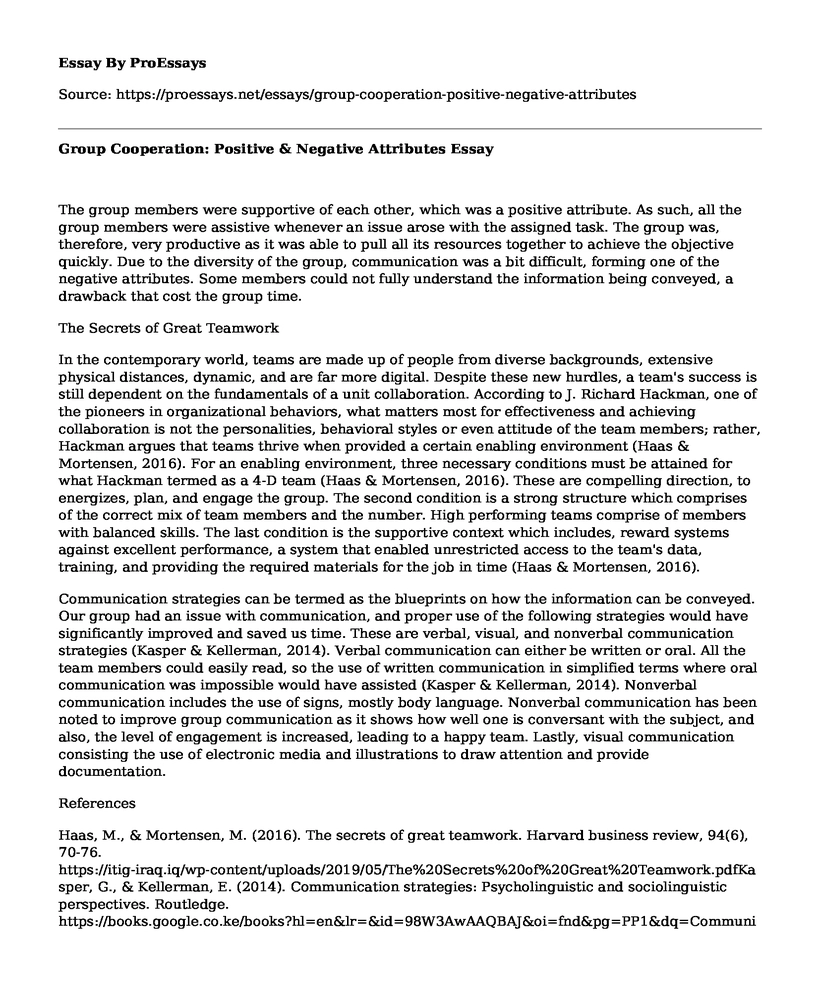The group members were supportive of each other, which was a positive attribute. As such, all the group members were assistive whenever an issue arose with the assigned task. The group was, therefore, very productive as it was able to pull all its resources together to achieve the objective quickly. Due to the diversity of the group, communication was a bit difficult, forming one of the negative attributes. Some members could not fully understand the information being conveyed, a drawback that cost the group time.
The Secrets of Great Teamwork
In the contemporary world, teams are made up of people from diverse backgrounds, extensive physical distances, dynamic, and are far more digital. Despite these new hurdles, a team's success is still dependent on the fundamentals of a unit collaboration. According to J. Richard Hackman, one of the pioneers in organizational behaviors, what matters most for effectiveness and achieving collaboration is not the personalities, behavioral styles or even attitude of the team members; rather, Hackman argues that teams thrive when provided a certain enabling environment (Haas & Mortensen, 2016). For an enabling environment, three necessary conditions must be attained for what Hackman termed as a 4-D team (Haas & Mortensen, 2016). These are compelling direction, to energizes, plan, and engage the group. The second condition is a strong structure which comprises of the correct mix of team members and the number. High performing teams comprise of members with balanced skills. The last condition is the supportive context which includes, reward systems against excellent performance, a system that enabled unrestricted access to the team's data, training, and providing the required materials for the job in time (Haas & Mortensen, 2016).
Communication strategies can be termed as the blueprints on how the information can be conveyed. Our group had an issue with communication, and proper use of the following strategies would have significantly improved and saved us time. These are verbal, visual, and nonverbal communication strategies (Kasper & Kellerman, 2014). Verbal communication can either be written or oral. All the team members could easily read, so the use of written communication in simplified terms where oral communication was impossible would have assisted (Kasper & Kellerman, 2014). Nonverbal communication includes the use of signs, mostly body language. Nonverbal communication has been noted to improve group communication as it shows how well one is conversant with the subject, and also, the level of engagement is increased, leading to a happy team. Lastly, visual communication consisting the use of electronic media and illustrations to draw attention and provide documentation.
References
Haas, M., & Mortensen, M. (2016). The secrets of great teamwork. Harvard business review, 94(6), 70-76. https://itig-iraq.iq/wp-content/uploads/2019/05/The%20Secrets%20of%20Great%20Teamwork.pdfKasper, G., & Kellerman, E. (2014). Communication strategies: Psycholinguistic and sociolinguistic perspectives. Routledge. https://books.google.co.ke/books?hl=en&lr=&id=98W3AwAAQBAJ&oi=fnd&pg=PP1&dq=Communication+strategies&ots=AqVedJzEFh&sig=4LaQRNrysKplCQkKajfxFZd0wC4&redir_esc=y#v=onepage&q=Communication%20strategies&f=false
Cite this page
Group Cooperation: Positive & Negative Attributes. (2023, May 07). Retrieved from https://proessays.net/essays/group-cooperation-positive-negative-attributes
If you are the original author of this essay and no longer wish to have it published on the ProEssays website, please click below to request its removal:
- A Discussion on Trade Agreements and Trans-Border Flows of Labor in Saudi Arabia
- Air Pollution and Air Quality Control and Noise Pollution Essay
- Initial Public Offering Value of Facebook Supply Paper Example
- Essay Example on Analyzing Community Challenges: A Necessity of Life
- Sexual Harassment in the Workplace: A Case Study
- Final Report: Summary of Criminal Investigation Process - Essay Sample
- Treatment versus Punishment - Free Essay Example







